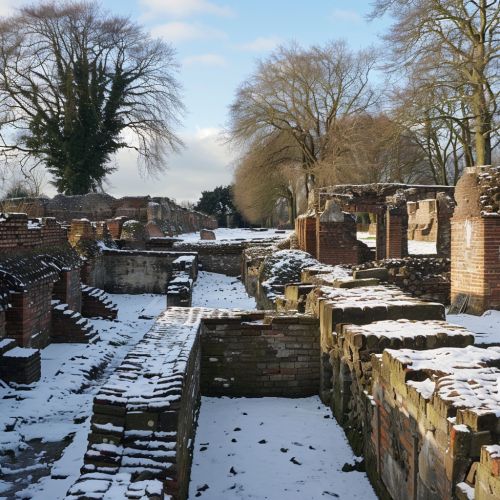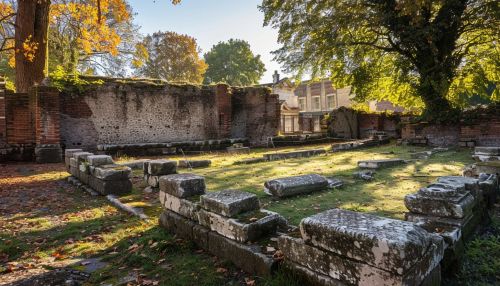History of Essex
Early History
The history of Essex, a county in the southeast of England, is rich and varied, spanning from prehistoric times to the present day. Archaeological evidence suggests that the area now known as Essex was inhabited as early as the Paleolithic era. Flint tools and other artifacts have been discovered, indicating the presence of early human activity.
Pre-Roman Period
During the Neolithic period, around 4000-2500 BCE, Essex saw the development of settled farming communities. Evidence of these early agricultural societies includes long barrows and causewayed enclosures, such as those found at Springfield Lyons and Orsett. The Bronze Age (c. 2500-800 BCE) brought further advancements, including the construction of round barrows and the introduction of metalworking. The Iron Age (c. 800 BCE - 43 CE) saw the emergence of tribal societies, with the Trinovantes being the dominant tribe in the region.
Roman Conquest and Occupation
The Roman conquest of Britain began in 43 CE under Emperor Claudius. Essex was quickly brought under Roman control, and the area became part of the province of Britannia. The Romans established several towns and settlements, including Colchester, which became the first Roman capital of Britain. The construction of roads, such as Stane Street and Pye Road, facilitated trade and communication throughout the region.


Roman Essex was characterized by a mix of urban and rural settlements. Villas, such as those at Cressing Temple and Great Chesterford, were built, showcasing the Roman influence on architecture and agriculture. The Roman occupation lasted until the early 5th century when the Roman Empire withdrew its legions from Britain.
Anglo-Saxon and Viking Periods
Following the Roman withdrawal, Essex became part of the Anglo-Saxon kingdom of the East Saxons. The kingdom was established in the 6th century and included parts of modern-day Hertfordshire and Middlesex. The East Saxons converted to Christianity in the 7th century, with the establishment of the Diocese of London and the construction of churches such as St. Peter-on-the-Wall at Bradwell-on-Sea.
The Viking Age brought significant upheaval to Essex. Viking raids began in the late 8th century, and by the 9th century, the region was part of the Danelaw, an area of England under Danish control. The Treaty of Wedmore in 878 CE marked the end of major Viking incursions, and Essex gradually became integrated into the unified Kingdom of England.
Medieval Period
The Norman Conquest of 1066 had a profound impact on Essex. The Domesday Book of 1086 provides a detailed record of landholdings and resources in the county, reflecting the changes brought about by Norman rule. Castles, such as those at Hedingham and Colchester, were constructed to assert control and defend against potential uprisings.
During the medieval period, Essex was predominantly agricultural, with a focus on arable farming and livestock. The wool trade became increasingly important, leading to the growth of market towns such as Saffron Walden and Maldon. The Black Death of the mid-14th century had a devastating impact on the population, leading to significant social and economic changes.
Early Modern Period
The Tudor period saw further developments in Essex. The dissolution of the monasteries under Henry VIII led to the redistribution of church lands, which were acquired by local gentry and nobility. The county played a significant role in the English Reformation, with notable figures such as Thomas Cranmer, the Archbishop of Canterbury, having connections to the region.
The 17th century was marked by the English Civil War, during which Essex was a stronghold of Parliamentarian support. The county saw several skirmishes and the siege of Colchester in 1648, which ended in a Royalist defeat. The subsequent Restoration period brought stability, and the county continued to develop economically and socially.
Industrial Revolution and Modern Era
The Industrial Revolution of the 18th and 19th centuries brought significant changes to Essex. The construction of railways, such as the Eastern Counties Railway, facilitated the growth of towns and the movement of goods and people. Industries such as textiles, engineering, and shipbuilding developed, particularly in towns like Chelmsford and Harwich.
The 20th century saw further urbanization and the expansion of suburban areas, particularly with the development of new towns such as Harlow and Basildon. The county played a crucial role during both World Wars, with several airfields and military installations located in the region.
See Also
- Camulodunum
- Cressing Temple
- Great Chesterford
- Hedingham Castle
- Colchester Castle
- Saffron Walden
- Maldon
- Thomas Cranmer
- Chelmsford
- Harwich
- Harlow
- Basildon
